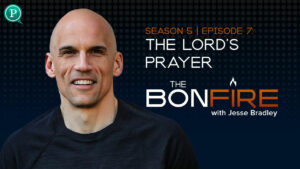It’s time to prep our tech for school! We’re going to do this in three parts and spare everyone the 1+ episode this almost became. 🤪
We first need to assess our tech. We need to know:
.📺 What tech are we using?
.⏱ When and where are we using it?
.🏥 Is it healthy?
This first step provides a solid base for tech conversations and the beginning of tech wins with our family so that we can fight for our kids, not with them, when it comes to technology.
Transcription:
Nathan Sutherland:
Heavenly Father, thank you for this opportunity to talk about technology. I ask for wisdom as I share these words, as we talk about how we can prep our tech for fall. Would you help us to think through what does it look like to love you and to use our technology because we have a purpose in you, not for purpose? In Jesus name, amen.
Hello, everyone, and welcome to the Gospel Tech podcast. My name is Nathan Sutherland and this podcast is dedicated to helping families love God and use tech. Today we are beginning our back to school series. I know some of you are already in school, but it’s really our prep tech for fall series is the way I’m picturing this, whereas we talked a lot over the summer about, all right, we’re either prepping for summer and new rhythms, or we’re trying to process these new rhythms.
Well, now we’re getting ready for new rhythms here in the northwest United States. We have got school coming up here in just a couple of weeks, T minus three weeks. Some of you on the East Coast, I know you’ve been rolling hard for two weeks already. Congratulations, you’re going to really enjoy next summer when you get it a month before us. But part of this conversation isn’t how do we make sure we’re perfect by the time school starts? Instead, it’s how are we intentional? So the timing isn’t as important as the process.
We’re going to do this in three parts. I almost did it all in one, but I’m trying to reform my ways, make this as applicable and I guess digestible, making up a word to say that, the idea that let’s make it in smaller pieces and let’s really work on applying this each time so that when we get to part two, we can apply parts of part one that maybe we were too busy or just didn’t have the time to put into play.
So we’re going to break this into three parts. The conversation is going to be first, how do we assess our tech? The second is going to be how do we build a hedge? And the third is going to be how do we use our tech on purpose? And the idea being instead of for purpose, how do we tie all this together and not just make it a series of things to do so that the bad world out there doesn’t get to our kids? But instead, since technology is always leveraged by people, how do we make sure that the tech we use is for God’s glory and our good, rather than trying to seek our good as though it’s separate from God’s kingdom, especially as Christians in this conversation? So that is the premise of our conversation today, and with no further ado, let’s get it started.
Welcome to the Gospel Tech Podcast, a resource for parents who feel overwhelmed and outpaced as they raise healthy youth in a tech world. As an educator, parent and tech user, I want to equip parents with the tools, resources, and confidence they need to raise kids who love God and use tech.
Thank you to everyone who’s helped make this podcast possible. Thank you for listening, for sharing, for liking and subscribing so you don’t miss any of our new content. You can check us out on YouTube. I’ve forgotten to mention that the last few weeks, but gospel tech, if you search that in YouTube, these videos will be populating there. I am actively hiring help to get more of this content out in more locations because we are busy with talks, which is awesome and busy with this awesome fundraiser coming up, and all these amazing opportunities mean I need some people to help me. So thank you for helping make that possible and for those of you who do financially support us, thank you because you’re the one that lets me or you’re the ones, there’s more than one of you, who lets me hire people and get this work done on a grander scale and to more people because that is at the end of the day, the end goal.
Growth is not our particular goal. Growth only matters if it’s helping to share the gospel and the hope of Christ into the tech world with more individuals who need that hope. So thank you for helping us do that. If you don’t support us, please pray about it. Maybe the Lord’s calling you to support us financially or with your skills and gifts and your times and talents, your relationships. Maybe you’re just called to listen and be encouraged by this, so thanks for being here for it. Today’s conversation, how do we prep our tech for fall and specifically this first one, how do we assess our tech?
And when we assess our tech, I really want to talk about which tech we’re using, when we’re using it and where we’re using it and keep it that simple. Parents, you could stop the podcast right now and have something to apply. Like, yeah, when are we using our tech? Which tech are we using and where are we using it? Just ask those three questions. Ask your little kiddos, I mean, down to six year olds, all the way up to a kid who’s living in your home and start to talk through, okay, does that line up with what we want as a family? Just that conversation is powerful.
Here, if you’ve already done that or if you want a little more depth to it, here’s what we can do. First piece is what tech tech are we even using? I break it into two categories. We’ve talked about this. This is a gospel tech staple as tool tech and drool tech. That idea that some tech helps us create and some tech helps us consume. That’s not good and bad tech, don’t mishear me, but it is different and the difference comes with how it’s designed.
Tool tech is designed to help you achieve your goals. You know it’s tool tech because it’s only there to leverage your abilities. You’re the one using it, it stops working when you stop working, and it gives you very few alternatives for what you could be doing with your time. Example, Microsoft Word, you want to go write something, Microsoft Word or Mac Pages or Google Docs or whatever you write into. There’s a writing app called Scrivener Scribner. I don’t know how you say the word. I use it, it’s great. It’s just a very nice way to keep basically a bunch of Word documents all organized for a single manuscript style work. It’s S-C-R-V-E-N-E-R, however you would say that, but those are awesome.
They’re all tool tech though. At no point did they send you notifications telling you about how good other people are doing or reminding you that you haven’t done anything and suggesting maybe you want to write some poetry right now or have you thought of writing a biography? It doesn’t do that. It simply lets you write, lets you save. You could go away from six hours, six days, you go away for six months, word is never sending you a notification. Now, I’m not going to say it never will, but actively right now, it’s purely designed as tool tech.
Drool tech, on the other hand, is designed, yes, to help you accomplish something you want. You want to have fun, you want to connect with friends. You want to create something, very cool. You want to learn something, awesome, but it’s also designed to take your time, your focus and your money. Now, it’s not all bad, but it is very different from tool tech. So if you were to use something like a 3D printer or you were to use something like a game design program, that’s all tool tech. It’s only doing what you want to do, but if you want to learn Spanish through something like Duolingo, it has gamification tied in. It has behavioral design and its job is to keep your time, your focus and your money. Will it motivate you to learn Spanish? Probably, yeah. It’s very good at helping you build a habit and that’s a habit you want. That would be an excellent example of drool tech done well.
Yes, they’re going to send you ads and sure they have rankings and skill levels and all sorts of competition and points and opportunities for you to buy the premium version, to save your opportunity to get more hearts or to redo lessons and all that. Right? That’s all gamification. That’s behavioral designed to take your time, your focus and your money, but it’s for a goal you signed up for. I want to learn Spanish, for example. Owen right now wants to learn Spanish, so he uses Duolingo. I use an iPhone. I use guided access. I lock it into Duolingo so he can’t click ads to get out of it, and it’s fine. It’s great, and we set a timer and we make sure it comes in proper priority. Have you eaten? Have you cleaned yourself? Have you read your Bible? Have you done your family tasks and chores? Great. Then here’s a 15-minute chunk of time that is appropriate to use this drool tech.
But it’s very important we know it’s drool tech. Just because he’s learning doesn’t change what it is. It’s designed to keep him longer, which means when I’m like, Hey, that’s our timer, he goes, oh, but I’m only partway through this lesson. Oh, but I just want to get this one extra heart. Right, I get it. The thing is really good at taking your time, you’re focus and your money. That was our timer. We’re done now. It’s important to set boundaries around drool tech. Tool tech very rarely is fighting you on that. Almost every time you have an argument about technology and you go, Hey, it’s dinner, and your kid is using a tech, drool tech is the one that goes five more minutes. You could get five more, right?
So that’s why we want to know what are we using? Drool tech is going to be social media, video games, streaming shows and music. Music falls in there because it’s algorithmically driven, meaning it knows where you are, it knows who you are and it’s going to give you suggestions. It’s not giving you what you asked for. I want to listen to Beethoven. It’s like, ah, but what about … Have you listened to any of this harpsichord before? Right? That’s what it’s trying to do, is to diversify your interest to get you into new things so that you come back more often, stay a little longer than you want, or are willing to spend a little more to get whatever the product is. So first we got to know what we’re using.
Right now, you could pause this podcast, have a conversation in your car, write it down on a sticky note or in notes on your phone, write down what tech you use and then take a guess. Is it tool tech? Is it purely designed to help you create, or is it maybe got some tool tech aspects, but with some drool tech under girdings? It’s designed to help you accomplish a goal, but with this taking your time, focus and money aspect to it? Take a moment, talk it out, and then come back to this because then we’re going to go into, all right, we know what tech we’re using, but that doesn’t answer when we’re having this bigger question of assessing our tech. We want us first assess what we’re using. Then we want to know how we’re using it, and I guess we’ll get back to that because I want to know really when and where is the next piece.
Our family needs some kind of boundaries and understanding. So where? I say this a lot, and I’m going to say it again, drool text specifically does not need to be in your bedroom, which means if you have technology that’s both like a laptop or any other device, an e-reader, but it has internet access, that’s going to probably make it drool tech. If it has apps that can be on it, it’s going to be drool tech at some point. Most apps are designed to take your time, you’re focus and your money. That technology does not be in our bedroom. Bedrooms need to be places of respite and sleep. Sure, you do homeschooling and someone needs to be on a zoom call or they need to be listening to a teacher present during certain hours of the day. There’s ways to do that well, and we’ll talk about it more next week when we talk about hedges.
That’s fine. You set a time and say, great, I get it. There’s 90 minutes. You need time in your room. Take the laptop, we have a hedge built, so I’m going to know what happens on that device. We have boundaries set on our network so that you can only go to certain websites during this time. Sure, even within that, you can run into trouble, but there are boundaries. There’s been conversations. Your child understands expectations, and if things go off the rail, you’re going to be notified because you are an active part of the technological conversation and you’re on your child’s team. You’re not just policing them. They’re not a problem to fix, right? They’re a person to love and you’re processing that, so that’s cool.
With that in mind, it’s not loving to allow drool tech to be in the bedroom, so we need to get anything that has social media, video games, streaming shows, streaming music. I would even argue news apps because while they, again can be tool tech, they’re not designed that way. They’re designed to get you to come back, to get you to scroll again, to get you to swipe down and see if new information pops up. That’s all behavioral design for engagement, time, focus, money. We want to be intentional about keeping space between that and our sleep. Sleep is so, so, so important, especially for young developing brains. So that’s our where, and the second part of where is where it goes when it’s out of our bedroom is into a public place.
Pick a room of your house. This is going to be our tech room, preferably not one that’s dark, closeted and on the far side of your home, preferably one in a public space. For us, it’s either our dining room table or our living room couch. Living room couch allows us to hear it and to see it. So yes, you can watch that video that’s on YouTube. We pull it up, I use an ad blocker and then they can go and watch their show for whatever amount of time we agreed on, or sometimes we watch shows through something like Amazon Prime where they’ll watch a Wildcats, fine. You can watch that here, but I need to be able to hear when that show’s done, so that just doesn’t roll into another video. It’s worth, by the way, turning off the autoplay feature so it doesn’t just roll into another video in case you’re out of the room doing something, because this is real life. But the where matters and we want to have that conversation. So what tech are we using, tool or drool? Where are we using it?
And then when? We need really clear ground rules on when are we going to use tech and the when involves, yes, time of day. So if I wake up early, can I use this tech? What time of day? If I get my schoolwork done, can I just use it whenever I have a free moment or do I have to wait for a specific amount of time? So hey, you can use this after school. When in terms of the length of time, Hey, we’re going to use it, but we’re only using it 30 minutes or for an hour or whatever your family agreement is on your rhythms and timing and age appropriateness for your kids, and then when for frequency. Yeah, you can have 30 minutes a day, but you can’t chew it up in three minute chunks, right?
This is an Andy Crouch idea. Andy Crouch wrote the Tech-Wise family and the Life We’re Looking For, two beautiful books on technology that are humble and gracious. They’re not preachy. They are very encouraging though, and I found them very challenging personally. A lot of the way I think about technology was solidified upon reading Andy Crouch work. It was thoughts I had and he gave me some great thoughts for it. He talks about tools versus instruments in the life we’re looking for, and I really liked that. I had already committed myself to tool and drool tech, but I love the idea and I think it’s really encouraging. So with that idea being when we’re using our technology, we’re going to keep it in its proper place. That’s the Andy Crouchism. Keep it in its proper place.
So yeah, you can use social media during this time of day for this amount of time, and then we walk away and we’re done, and if you need to do more, tomorrow will happen and you’ll be fine. That’s the mentality we need to get ourselves into, so we’re not beholden to our technology. We’re not allowing ourselves to be trained from just little itty bitty reps that we’re building through lots and lots of tiny practice. That at the end of the day does take a lot of time, but more importantly, it gets us used to doing this and it makes it normal and it makes it the way we operate when maybe that’s not what we want. Maybe that’s not what’s best for us. So we know when we use it, we know where we use it, and then we want to know if it’s healthy, and this is the final part of this conversation.
I mean, the real thing we’re trying to figure out here is, okay, we have technology, we’re using it. Is it a net gain? We look at our reset. When we try to figure out is this tech a good choice for us right now, when it comes to assessing our tech, we’re going to assess is it actually a problem? We know it’s a tool, we know it’s drool, we know where we’re using it. We’ve got all that, but is this a good fit for our family in this season of life for these purposes? It goes with a drool tech, so check that with your games, with the music you play, the shows you watch, the news you engage, certainly the social media that you’re on, great, and your tool tech.
Some of us have problems with email. It’s not trying to be addictive. It doesn’t get any bonus. There’s no ads through email. They’re not trying to drive you back to email so that you’ll use it more, but it is really sticky, especially for those of us running our jobs and businesses. Right? We love sending those extra emails and then going back and checking, is it here? Did we get that thing? Do I have that next job? Did I get that next response? That can be very exciting and encouraging and it can be a bit of a problem. I had to remove the app off my phone so I can only check from a browser or from my work computer. I have to set times of day and actually days. I don’t check my email every day because for me, that was a thing.
How did I get to that point? Well, I had to ask this question, reset, is it healthy? Reset is we look at our tech, tool or drool, and ask, does this tech improve or impede our relationships and responsibilities, our emotions, our sleep, our enjoyment, and our time? When you have a reset, this isn’t, oh, I’ve got a problem in one of these five, therefore I crush this and never use the tech again. That might be what you do. It’s what I’ve done with gaming. I had a five out of five on my reset that was negative in all five areas. Gaming impeded my relationships and responsibilities, my emotions, my sleep, my enjoyment and time. It was not a positive in any area. There were positive aspects, but the net result was always bad.
So sure, I was relational when I gamed, but I also skipped seeing people to get back to my video games, so sure. Really all I was saying is when I see people, they’d better want to play video games, and if they don’t want to play video games, I just won’t see them. So I can’t argue that games are relational in any honest way in that conversation, but for you, maybe that’s not it. Maybe it’s like, you know what? Just that one game really gets me, or just social media needs some more boundaries around it because it’s impacting my relationships, and I want it to be positive, and it can be, but it’s going to have to be 15 minutes, two days a week. It’s going to have to be this particular window of my day and then no more, and I can’t check it again, whatever it is for you.
So your relationships, responsibilities, your emotion, sleep, enjoyment and time, and just to break those down quickly while if … there’s lots of episodes, you can go back and check, I’ll say it here, relationships and responsibilities, meaning if your technology for you and for your children, if when you go on this piece of technology, your relationships are improved, they’re stronger and your responsibilities are more thoroughly followed through on, that’s awesome. Your yes is yes, your no is no, and your tech helps you.
So my smartphone keeps my meetings there and the links are right there, and I can type notes about what we’re supposed to talk about. Awesome. I’ve got three meetings today. My technology helps me with that. So on that piece, smartphones improve my relationships and my responsibilities, but I don’t have social media on it. I don’t have email on it because I found that those aspects of my technology actually harm my relationships and responsibilities. All right? So I use both those through my browser or I use them through my work computer because that’s where my social media focus really is, is trying to extend this gospel work to the internet. Okay, cool. Fixed it, right? I had a impeding issue, I removed video games, but I kept smartphones with some adaptations. That’s the goal of the reset in assessing our technology for this fall.
Then we look at our emotions. Really all we’re looking at here is are our high highs and our low lows tied to it? Do I need this piece of technology to be okay? Then we look at sleep. Again, drool tech in the bedroom is really our number one. If you have a smartphone in your room and you’re using it as an alarm clock, you don’t need $1,000 alarm clock. You can buy one off Amazon for 30 bucks. It uses two AAA batteries. I can put the link in the show notes. It’s a great little alarm clock. We use it and it’s great. No internet, works wonderfully and you can take it wherever you go because it’s battery run. Replace them every six months to a year or use rechargeable and just recharge them every six months to a year.
Then after sleep, we go to enjoyment, and really we’re looking at does this piece of technology absorb our enjoyment or enhance our enjoyment? Meaning do I play video games because I’m already happy and when I play these video games, I just get more joy? Or in my case, am I gaming for joy because life is lame and I need to get back to this to be okay? That’s what we’re talking about. Yes, my kid loves the social media and that’s really good. They’re getting a lot of enjoyment, but they don’t enjoy music or sports or their friends or the family anymore. When they get on this piece of technology, everything else wilts and they become more isolated and more alone and their enjoyment, the things God wired them to love don’t really show up anymore. That’s what we’re talking about.
And the final one is time. Really, can you be content with a limited amount of time with this technology? Can you set a limit, walk into it and be okay with it? So in this conversation then, what we just looked at for our first part of prepping tech for the fall is we’re going to assess our tech. We’re going to assess which tech we’re using. Is it tool or drool? Is it fitting our family in the season? Where do we use it and when? The location matters just for safety and conversation? Yes, even with our older children, certainly there are children that earn more independence. When they get a smartphone, they’re going to have some independence. They leave the house with that thing. There’s going to be some accountability that’s part of the hedge, but they’re not just going to be given it. Please don’t give your child that amount of trust if they’ve not proven in little things that they’re trustworthy with it. That’s the where and the when.
Finally, we have our reset. Is it healthy? Some of us, we went through this [inaudible] you know what? Our technology’s improving all these areas. That’s awesome. As we’re going to talk in the third episode of using our tech on purpose, we want our children to use all the tech that makes them look more like Jesus. If they use a video game or social media or listen to music or watch shows or engage the news and it brings out more love and joy and peace and patience and kindness and goodness and gentleness and self-control, amazing. Let’s keep using that technology. Let’s learn new ways to bring people into those conversations and continue to spread the hope, joy, and truth of Christ. That’s what we want.
If however, it makes us cynical or jaded or envious or greedy or lustful or sensual or any other negative fruit that comes from sin burrowing into our hearts and coming from our hearts now are these nasty, terrible things we need to repent of? Sometimes that repentance requires action, otherwise we’re not being sorry. We’re just like, well, sorry that happened again. I’m going to keep doing it because it’s awesome. That’s where repentance comes in. That’s what the reset is meant to do. We’ve assessed our tech.
Now, as you look at your fall calendars, you look at school starting or having started, sports starting up, friends coming in, we want to make sure that we’ve assessed our tech and we’re in a position to begin that tech conversation. So ask your kids, what tech are we using? Where is it? When do we use it, and is it healthy right now? And then join us next week because we’re going to talk about, all right, but what can we do to help it be healthy?
So thank you for being a part of this conversation. I hope it was encouraging, challenging, and hope filled for you, and I hope you’ll join us next week as we continue this conversation about how we can love God and use tech.







